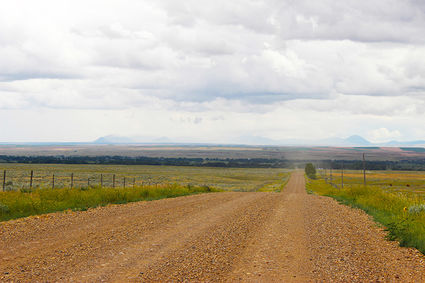Dry weather conditions result in official actions affecting Blaine County
July 5, 2017

Steve Edwards
This late June view toward the Little Rockies and the Bear Paws suggests a possible rainstorm might be in progress. There are general reports around the county about brief episodes of rain, but always spotty and, to date, not adequate.
An especially dry spring and warming temperatures are resulting in several official actions that will affect commerce and life in Blaine County. Montana Governor Steve Bullock issued an executive order and an official request to U.S. Agriculture Secretary Sonny Perdue. Both actions have to do with providing help to nineteen eastern Montana counties as well as Fort Belknap and Fort Peck Indian Reservations.
An inter-agency order for Stage I Fire Restrictions affected several areas in north central Montana, including Blaine County. And the U.S. Drought Monitor report issued a D2 drought condition for northeast Blaine County, triggering a process for livestock producers to access CRP lands with proper application through the Farm Service Agency.
All these events occurred during the last full week of June. Here's a brief rundown of the weather and resulting official actions.
Weather conditions and
early drought designations in eastern Montana
While the western states are entering their typical dry season, much of the west coast is still enjoying surplus moisture from earlier spring rains and large snowpack runoff. Per the U.S. Drought Monitor-a combined effort of several national agencies from the Agriculture and Commerce Departments-the one exception in the western region is eastern Montana, where "even cooler-than-average temperatures over the last several days did not appear to make a positive difference on the drought impacts being felt by dryland producers."
Extending in to south central North Dakota (in the Great Plains drought region) as well, for the week ending June 25 this 'flash drought' resulted in dramatic drops in topsoil moisture. Topsoil moisture percent of "short to very short" was 69%, an increase of 20% compared with the previous week and the highest percentage among all the states.

In a June 23 letter to U.S. Agriculture Secretary Sonny Perdue requesting drought designations for several counties, Governor Bullock noted the drought monitoring service had already designated the Montana counties of Daniels, Garfield, McCone, Roosevelt, Sheridan and Valley as "D3-Extreme Drought"-making them immediately eligible for Secretarial Designation as drought stricken. In the letter the Governor asked for drought designations for an additional 14 eastern counties, including Blaine County, as well as Fort Belknap and Fort Peck Indian Reservations.
Montana Executive Order No. 5-2017, issued by the Governor's Office on the same day as the letter to Secretary Perdue, outlined how "...since on or about April 1, 2017, a widespread and sustained abnormally dry weather pattern has created worsening drought conditions in eastern and central Montana due to a lack of soil moisture and precipitation..." In the executive order all state department heads were directed to "fully cooperate" with efforts to ease the effects of the drought-including lifting of certain restrictions regarding the hours hay could be trucked and temporary suspension of hours of service regulations by the Department of Transportation.
An inter-agency dispatch representing several national and state fire-fighting agencies, ordered Stage 1 Fire Regulations in to effect on June 30. The regulations restrict or prohibit campfires and smoking outdoors except under certain conditions. The Stage 1 regulations apply in Blaine, Roosevelt, Sheridan and Valley Counties. Representatives of Fort Belknap Indian Reservation also elected to follow the fire restrictions on tribal lands.
Blaine County receives D2 drought status on June 29, 2017
On the June 29 Drought Monitor report the northeast corner of Blaine County was designated with a D2 drought intensity-Severe Drought.
The staff at the Farm Service Agency (FSA) in Chinook had been following the daily reports of the drought monitoring service. An FSA spokesperson said, "The D2 designation triggers a process that mainly applies to "emergency grazing" of CRP (Conservation Reserve Program) lands.
CRP guidelines allow producers to take land out of production and establish long-term programs, using certain plant species, to control soil erosion, improve water quality and develop wildlife habitat. When certain natural disasters occur, emergency relief can be provided to livestock producers to graze or hay CRP land.
The local spokesperson added, "The D2 designation triggers the potential grazing of CRP lands. But a producer must sign a grazing plan before accessing the CRP with livestock." Producers should contact the local FSA office in Chinook for details (357-2320).
A retired rancher, in the northeast sector of the county, said, "It's really dry but not as bad as 1986. That year many producers had to move livestock to other parts of the state to find adequate pasture." He said he worried that diminished pastures would affect the ability of ranchers to produce calves with adequate weight for the fall market. He added, "There has been some rain but it's been spotty. The effects have been varied across the area."
A dryland farmer south of Chinook said, "We are surviving on the excess rains of the last several years for this year's crops. Our winter wheat is made. Barring any prolonged hot periods in the immediate future, there should be enough soil moisture to allow the spring wheat to mature."
One north dryland farmer put an optimistic twist on the situation. He said, "Every day is just one day closer to rain." Hopefully that day with rain will come soon.

